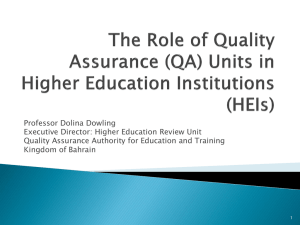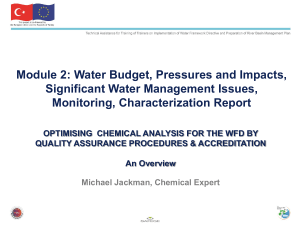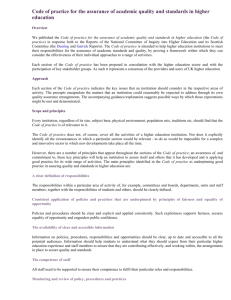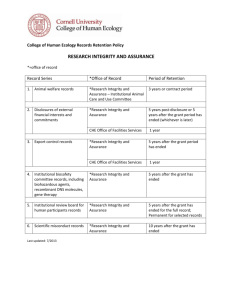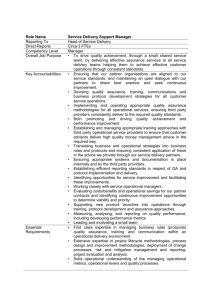QUALITY ASSURANCE IN TECHNICAL INSTITUTION
advertisement
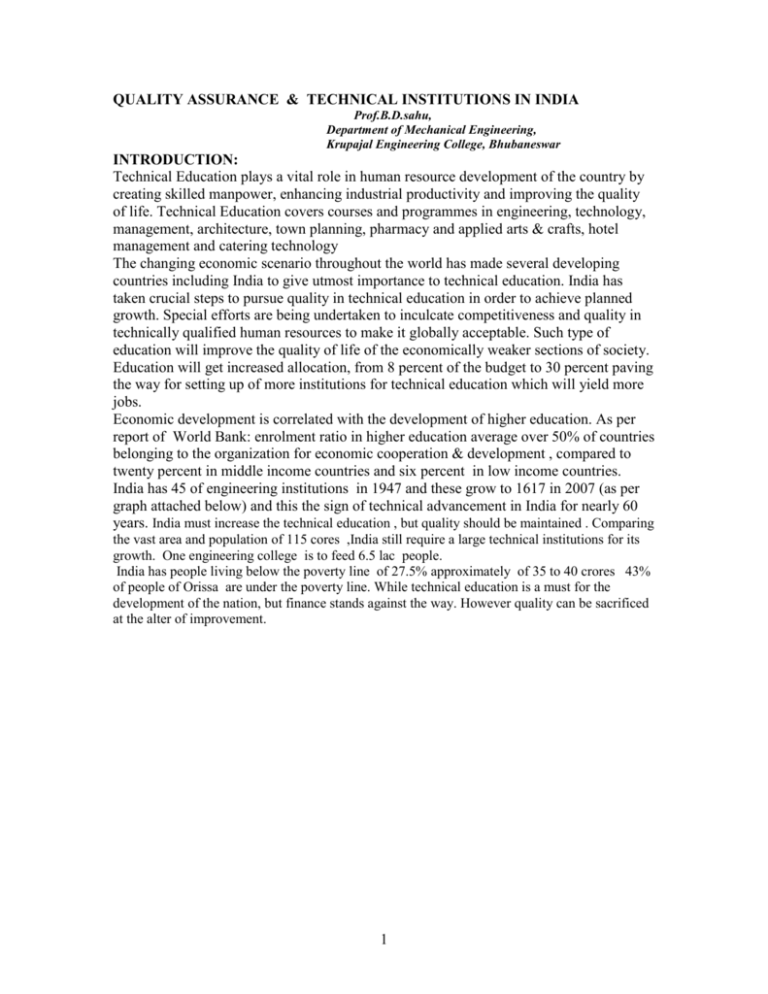
QUALITY ASSURANCE & TECHNICAL INSTITUTIONS IN INDIA Prof.B.D.sahu, Department of Mechanical Engineering, Krupajal Engineering College, Bhubaneswar INTRODUCTION: Technical Education plays a vital role in human resource development of the country by creating skilled manpower, enhancing industrial productivity and improving the quality of life. Technical Education covers courses and programmes in engineering, technology, management, architecture, town planning, pharmacy and applied arts & crafts, hotel management and catering technology The changing economic scenario throughout the world has made several developing countries including India to give utmost importance to technical education. India has taken crucial steps to pursue quality in technical education in order to achieve planned growth. Special efforts are being undertaken to inculcate competitiveness and quality in technically qualified human resources to make it globally acceptable. Such type of education will improve the quality of life of the economically weaker sections of society. Education will get increased allocation, from 8 percent of the budget to 30 percent paving the way for setting up of more institutions for technical education which will yield more jobs. Economic development is correlated with the development of higher education. As per report of World Bank: enrolment ratio in higher education average over 50% of countries belonging to the organization for economic cooperation & development , compared to twenty percent in middle income countries and six percent in low income countries. India has 45 of engineering institutions in 1947 and these grow to 1617 in 2007 (as per graph attached below) and this the sign of technical advancement in India for nearly 60 years. India must increase the technical education , but quality should be maintained . Comparing the vast area and population of 115 cores ,India still require a large technical institutions for its growth. One engineering college is to feed 6.5 lac people. India has people living below the poverty line of 27.5% approximately of 35 to 40 crores 43% of people of Orissa are under the poverty line. While technical education is a must for the development of the nation, but finance stands against the way. However quality can be sacrificed at the alter of improvement. 1 GROWTH OF ENGINEERING COLLEGES SINCE 1947 1800 1617 1559 1495 1600 1400 1346 1208 NUMBERS 1200 1057 1000 838 776 800 600 400 337 662 558 471 375 258 200 0 1940 Series1 46 80 1950 1960 151 179 1970 1980 1990 2000 2010 YEAR India-destination for Technical education Approximately 7.2 % of adults in the 17-24 age group have privilege of getting higher education . As compared to this the figure for US and Australia is 80% ,Canada 88%, Finland 74%,UK 52% . This figure for India is to be augumentedat least by a modest 25% before 2020. In India , total enrolment in higher education institutions is 10.5 million, just 11% of total relevant age group (17-23 years) in the population. On this count, India fares poorly compared to South east Asian countries like Philippines (31%) ,Thailand (19%), Malaysia (27%) , China (13%) Regarding public expenditure on higher education , India is among the lowest in the world , with public expenditure per student at $406 compared to China ($2728),Brazil ($3986) ,Indonesia ($666) and Malaysia ($625) Thus the urgent need to enlarge the role and relevance of our universities and technical institutions to reach a larger community 2 QUALITY ASSURANCE: The quality of care has three components: the goodness of technical care, judged by its effectiveness, the goodness of the interpersonal relationship, judged partly by its contribution to technical care, and the goodness of the amenities. Quality assurance protects and enhances quality through system design and performance monitoring. Monitoring may occur informally in the course of collaborative practice. Formal monitoring is conducted by: systematically collecting information about the process and outcome of care, (2) identifying patterns of practice, (3) explaining these patterns, (4) acting to correct deficiencies, and (5) verifying the effects of remedial actions. Rather than being a policing activity, monitoring implements professional accountability and contributes to rational management by documenting the quality of the product. The effectiveness of quality depends in specified ways on (1) leadership, (2) organizational characteristics, (3) characteristics of health care professionals, (4) features of the method of monitoring, and (5) methods used to influence practitioner behaviour. Quality assurance in higher education is defined as systematic management and assessment procedures adopted by a higher education institution or system to monitor performance and to ensure achievement of quality outputs or improved quality. Quality assurance aims to give stakeholders confidence about the management of quality and the outcomes achieved. Accreditation refers to a process of assessment and review which enables a higher education course or institution to be recognised or certified as meeting appropriate standards. In Australia, the term accreditation has developed three specialist meanings: a process of review or assessment conducted by a government agency to enable a minister or approved authority to recognise and approve a higher education institution or course; a process of review carried out by a government registration body to enable graduates of particular courses to practise in the particular State or Territory; and a process of 3 assessment and recognition carried out professional associations. In this report, we are primarily concerned with the first usage. Quality in the context of higher education can be defined as a judgement about the level of goal achievement and the value and worth of that achievement. It is also a judgement about the degree to which activities or outputs have desirable characteristics, according to some norm or against particular specified criteria or objectives. Quality needs no definition, you recognize it when you see IT'. Quality is a complex, multidimensional entity, no doubt; but so are many other things of significance, and we have to deal with them; such as, for example, development, growth, excellence, democracy, religion Quality Engineering Education demands a pro cess of continuous improvement of and dramatic innovation in student, employer and societal satisfaction by systematically and collectively evaluating and refining the system, practices and culture of engineering education institutions.' WHILE QUALITY assurance has always been a matter of concern and significance in education, in general, and in professional education such as technical education in particular, the recent quantitative expansion of an unprecedented nature, in India, has caused educators to devote careful attention to the quality aspect. There already exist several regulatory mechanisms for ensuring minimum standards before an institution is started. However quality assurance entails an assessment of the performance of the institution in delivering Education of the prescribed quality. Quality is very specific; it involves continuous improvement; it can be achieved by prevention it implies zero defects or errors; it includes correction of errors. Quality is not something vague; not something achieved by inspection, testing and checking; nor acceptable quality levels Quality perceptions depend to a large extent on the particular sector or group that is considered. Three such perceptions are indicated below National Funding Agencies: education for largest number at minimum cost Educational Administrators: image and reputation of their institutions Faculty: student learning and satisfaction The scope of quality includes manufacturing activities, business processes, and services for focuses on the need of the both external and internal customers Quality Assurance of other countries: In Australia Quality assurance in higher education is defined as systematic management and assessment procedure adopted by higher education institution or system to monitor performance and ensure achievement of quality outputs or improved quality . Quality assurance aims to give the stackholders confidence about the management of quality and outcome achieved. For European nation “The Bologna Declaration “ signed on June ,1999 among 29 European countries states that the European area for higher education has to wider access ,life long learning , skills training, social exclusives. The higher education should not remain for marginal activities, it should demonstrate its added value and become better integrated into higher education policy. 4 In US quality of assurance is judged by the facilities ,finance, faculty credential , library and in structural technology support service for students. They check the institution’s integrity and its commitment to quality enhancement . The institution dedicates themselves to enhancing the quality of their program and services within the context of their missions, resources of capacities and create an environment in teaching ,public services, research and learning occur. PURPOSE OF EVALUATION OF QUALITY IN HIGHER EDUCATION Purpose Focus Planning of Funding Validating Accrediting Awarding MAINTAINING ENHANCING University Department Programme Teacher LEARNING OUTLINE DISPLAY OF CHARACTERISTIC OF QUALITY & THEIR EVALUATION Focus of Characteristics Criteria of each Purpose of Method of Evaluation of Quality character Evaluation Evaluation University Department -Teaching -Research Programme Teacher LEARNING INDICATORS FOR QUALITY ASURANCE : These are the indicators required for the quality assurance. . Indicators of student, faculty and institutional quality Indicators of student Number of applications per seat quality Indicators of faculty quality Number of applications for faculty position, at different levels Diverse preparation and background Academic quality, in terms of of entering students publications, honors, awards, patents, sponsored projects and consultancy. Number completing degree Retention success; turn-over Time to complete degree Proportion undertaking practical Training Teaching quality, innovative initiatives Publication records Proportion participating in research and development Employment profiles and salaries on Graduation Sponsored research, consultancy and continuing education activities Professional society and public service involvement 5 Indicators of institutional quality The utilization of strategic planning processes Interaction with the environmentÐ industry, profession, community. Mobilization of resources for institutional development Diversity of external financial support Demand from outside agencies for R & D and continuing education Adjunct appointments with Industry Inter-disciplinary activities Number taking up post-graduate studies Ability to mobilize resources for department and institution Satisfaction levels of students and Internal and external (national and Employees international) honors and awards Perceived reputation of graduates and Quantum of practical experience alumni, nationally and internationally Proportion of foreign students Effectiveness of student counseling Number becoming entrepreneurs Faculty career satisfaction levels. Self-assessment and accreditation processes Alumni involvement Perceived reputation, nationally and internationally Use by national agencies as think tanks and for technology development Leadership in education and research SELF-ASSESSMENT (SWOT) Self-assessment is often performed through a SWOT analysis. SWOT is an acronym for S- Strengths, W-Weaknesses, O- Opportunities and T- Threats; It refers to the internal strengths and weaknesses of an organization or institution, and the environmental opportunities and threats facing the organization. SWOT analysis involves a systematic identification of these factors and the strategy that reflects the best match between them. It is based on the premise that an effective strategy maximizes an institution's strengths and opportunities, but at the same time minimizes its weaknesses and threats. Strengths and weaknesses are internal to the institution and are within its control; they may be manipulated to suit a particular situation. Ideally, an institution should build on its strengths, dilute its weaknesses, exploit the opportunities, and avoid the threats. SWOT analysis of a traditional engineer Strengths Analytical capabilities Design capabilities: ability to handle open-ended problems; ability to handle poorly-defined problems; creativity and innovation Decision-making, including problem-solving Graphical communication skills Discipline, work ethic. Weaknesses Ability to work in a team Inter-disciplinary knowledge Practical orientation (academics) Commercial orientation Introspective nature, modesty Oral and written communication skills Integrative skills Ability to employ IT Obsolescence (remedy: continuing education) Inter-personal skills Public perception and recognition Opportunities Threats Most real-life problems require contributions from Engineers Competition from scientists, economists, financial experts, National policies recognize role of S & T administrators in high-level decision-making bodies Business recognizes role of technology Quantitative expansion in technical education without Ambition of bright youth to become Engineers simultaneous quality assurance Globalization offers opportunities for acquisition of Industrial development entails depletion of natural resources and state-of-the art technologies environment degradation -engineers held responsible for these Self evaluation requires 3 aids Through “mirror” i.e. external assistance (work of the quality agencies accrediting ,validating bodies ,audit units and inspectors) 6 Aid of training (staff development ) Need for national and international level information Quality Assurance components Human Resources Faculty Staff Students Teaching Learning process Input Physical Resources Lab Library Infrastructure Financial Resources R&D IC & SR Continuous Resources Global used Quality Indices for Academic Institutions 1. Depth of course work 2. Applications/seat 3. Staff student ratio 4. Pass ratio 5. Alumni achievement 6. Endowment 7. Library/ BW 7 OUTPUT Tangible outcome Man power Research papers Products & Process Patents Books Short term course International / National Conference QIP MOUs Participation in National decision making Professional Society Activities Editorial Board Intangible outcomes Brand equity Scholarship Reputation Credibility National image / Pride Excellence ,Quality Role model 8. Laboratories 9. Reputation / placement 10. Faculty Quality etc 11. R& D papers/ Patent 3 keys to Technology Planning & Management Encourage and train faculty Support student productivity – learning efficiency Technology integrated curriculum Teaching Process Fundamental Class room dynamics Processes and services to promote 1. Student comprehension 2. Recall 3. Critical thinking Imaging import/system 1. Documentation 2. Graphics 3. Graphing 4. Multimedia ICT Technologies 1. Better education 2. Cost effective 3. Value adding for average student QUALITY ASSURANCE IN INDIA National Board of Accreditation (NBA): National Board of Accreditation (NBA), a body under AICTE, is the only authorized body in India entrusted with the task of undertaking accreditation of technical education programmes. All programmes on technical education including those offered by University Departments are accredited by NBA. The NBA evaluates the quality of programmes offered by educational institutions from Diploma to the Postgraduate levels in Technical Education. Accreditation is based on an 8 point criteria which includes organisation and governance, financial resources, allocation and utilization, physical resources, human resources, teaching/learning processes etc. 8 There has been a substantial increase in the number of accredited programmes in India. ACCREDITATION OF PROGRAMMES Discipline Engineering Pharmacy Management HMCT MCA As on Dec 12, 2003 Programmes (Institutions) 759 (169) 38 (15) 51 (41) 02 (02) 29 (29) As on Jan 11, 2008 Programmes (Institutions) 2005 (512) 67 (32) 106 (92) 04 (04) 53 (53) Percentage of Accredited Programmes. 36% 8% 10% 9% 5% National Assessment and Accreditation Council (NAAC) National Assessment and Accreditation Council, an autonomous body, has been established by the University Grants Commission in 1994 in pursuance of the recommendations made by the National Policy of Education, 1986 and the Prgramme of Action (POA), 1992 which lay special emphasis on evaluating the quality of higher education in India. The prime mandate of NAAC, as envisaged in its Memorandum of Association (MoA), is to assess and accredit institutions of higher learning, universities and colleges or one or more of their units, i.e., departments, schools, institutions, programmes, etc. The NAAC functions through its General Council and Executive Committee where educational administrators, policy makers and senior academicians from a cross-section of system of higher education are represented Under the new methodology introduced by NAAC w.e.f. 1st April, 2007, the higher education institutions are assessed and accredited by a two-step approach. In the first step, the institution is required to seek ‘Institutional Eligibility for Quality Assessment (IEQA)’ and the second step is the assessment and accreditation of the institute under the grades ‘A’, ‘B’, ‘C’ for accredited institutions; and ‘D’ for those which are not accredited. NAAC has identified seven criteria Curricular aspects, ii. Teaching-learning and evaluation, iii. Research, Consultancy and extension, iv. Infrastructure and learning resources, v. Student support and progression, vi. Governance and leadership and vii. Innovative practices as the basis for its assessment procedure 9 Dale’s Cone of Experience People generally remember 10% of what they read 20% of what they hear 30%of what they see 50% of what they Hear & see People able to:(learning outcome) Real Hear Define , Describe List , Explain View image Watch video Visit Exhibit /sites Watch a Demonstration Demonstrate Apply practice 70% of what Design collaborative lesson They say & write Participate in hands-on activity 90%of what Simulate Model or Experience they say as Design / perform a presentation Do they do a “ a Real thing” thing Analyse Design Create Evaluate People can utilize 90% of their energy to analyze , design, create and evaluate the better innovation for the betterment of their society. Japan could able to rise to the top from the ashes of Hiroshima and Nagasaki due to their Endeavour and dedication in the technical field. Measurements in Science & Technology Lord Kelvin: When you can measure what you are speaking about and express it in numbers , you know some thing,----McNamara Fallacy : We tend to give too much importance to what is measurable rather than trying to measure the important CONCLUSION. National policy of Education ,1986 updated in 1992 envisage improvement and expansion of education in all sectors , elimination of disparities in : access and laying greater stress on improvement of quality and relevance of education at all levels including technical and professional studies Vision of the AICTE states 10 “ To be a world class organization leading technological and socioeconomic development of the country by enhancing the global competitiveness of technical man power and ensuring high quality technical education to all sections of the society .” The quality assurance is ultimately the responsible of the institution themselves . The real and enduring quality can only come from by the universities as a result of self evaluation and peer review. REFERENCES: 1. Quality Assurance in higher education by Malcom Frazer 2. Role of accreditation in promoting quality assurance of technical education – by Prof. R.Natarajan 3. Quality Assurance of technical education in India – Prof. Prasad Krishna 4. International Initiatives & trends in quality assurance for European Higher education- Carolyn Campbell & Dr. Marijk van der Wende 5. Repositioning Quality Assurance – Grant Harman & V Lyln Meek 11

